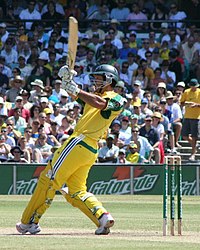Match structure
The toss
- For more details on this topic, see toss (cricket).
The two opposing captains toss a coin before the match, and the captain who wins chooses either to bat or bowl first. The captain's decision will be based on whether the team's bowlers are likely to gain immediate advantage from the pitch and weather conditions (these can vary significantly), or whether it is more likely that the pitch will deteriorate and make batting more difficult later in the game.
Overs
- For more details on Overs, see Over (cricket).
Each innings is divided into overs, each consisting of six consecutive legal (see "Extras" for details) deliveries bowled by the same bowler. After completing an over, the bowler must take up a fielding position and let another player take over the bowling.
After every over, the batting and bowling ends are swapped, and the field positions are adjusted. The umpires swap so the umpire at the bowler's end moves to square leg, and the umpire at square leg moves to the new bowler's end.
End of an innings
- For more details on End of an innings, see End of an innings (cricket).
An innings is completed if:
- Ten out of eleven batsmen are 'out' (dismissed) — the team are said to be all out.
- The team has only one batsman left who can bat (the others being incapacitated either through injury, illness or absence) — again, the team are said to be all out.
- The team batting last reaches the score required to win the match.
- The predetermined number of overs are bowled (in a one-day match only, usually 50 overs).
- A captain declares his team's innings closed (this does not apply to one-day limited over matches).
Playing time
- For more details on Playing time, see Playing time (cricket).
Typically, two-innings matches are played over three to five days with at least six hours of cricket played each day. One-innings matches are usually played over one day for six hours or more. There are formal intervals on each day for lunch and tea, and shorter breaks for drinks, where necessary. There is also a short interval between innings.
The game is only played in dry weather. Additionally, because in professional cricket it is common for balls to be bowled at over 90 mph (144 km/h), the game must be played in daylight good enough for a batsman to be able to see the ball. Play is therefore halted during rain (but not usually drizzle) and when there is bad light. Some one-day games are now played under floodlights but, apart from a few experimental games in Australia, floodlights are not used in longer games. Professional cricket is usually played outdoors. These requirements mean that in England, Australia, New Zealand, South Africa and Zimbabwe the game is usually played in the summer. In the West Indies, India, Pakistan, Sri Lanka and Bangladesh games are played in the winter. In these countries the hurricane and monsoon season coincides with summer.
Batting and scoring runs
- For more details on scoring, see scoring (cricket).
Batting

Batsmen strike the ball from the batting crease, with the flat surface of a wooden bat. If the batsman hits the ball with his bat, it is called a shot (or stroke). If the ball brushes the side of the bat it is called an edge or snick. Shots are named according to the style of swing and the direction aimed. As part of the team's strategy, the player may bat defensively, blocking the ball downwards, or aggressively, hitting the ball hard to empty spaces in order to score runs. There is no requirement to run if the ball is struck. The batsman also automatically scores runs if he manages to hit the ball to the boundary.
Batsmen come in to bat in a batting order, decided by the team captain. The first two positions, the "openers", face the most hostile bowling, from fast bowlers at their freshest and with a new ball. After that, the team typically bats in descending order of batting skill, the first five or six batsmen usually being the best in the team. Then follow the all-rounders — bowlers or wicket-keepers who can bat decently — and finally the pure bowlers who rarely score well. This order may be changed at any time during the course of the game.
No comments:
Post a Comment